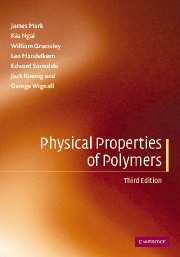6 - The application of molecular spectroscopy to characterization of polymers
Published online by Cambridge University Press: 05 June 2012
Summary
Introduction
Molecular spectroscopy has made a lasting impact on polymer chemistry and technology by providing direct methods to study polymer structures and their mutual interactions. Polymer scientists have found great utility in the commercially available spectroscopic instrumentation which is becoming increasingly widely available and easily applied to day-to-day polymer-characterization problems. In addition, there continues to be a wealth of new and evolving spectroscopic technologies that enhance the utility of molecular spectroscopy for the determination of the molecular architecture of synthetic polymers.
Most polymers are complex mixtures of materials of various sizes (relative molecular masses) and chemical compositions and with various end groups and molecular architectures. Thus, synthetic and biological polymers present a particularly difficult problem for molecular characterization due to the multicomponent nature of the systems. In practice, no single spectroscopic or analytic technique is sufficient for the complete determination of all of these structures and distributions.
The molecular architectures of synthetic polymers are determined by composition and composition distribution along the chain, functionality and functional-group distribution (block, random, blend), and chain length and chain-length distribution. Additionally, the main-chain structure of the polymer is controlled by the nature of the regiochemical (head-to-tail, tail-to-tail, head-to-head) and stereochemical (isotactic, syndiotactic, atactic) monomer insertion. Topological structures including cyclics, branched, dendritic, and cross-linked systems have been prepared, which are finding uses in polymer applications and require molecular characterization as well.
- Type
- Chapter
- Information
- Physical Properties of Polymers , pp. 383 - 423Publisher: Cambridge University PressPrint publication year: 2004



